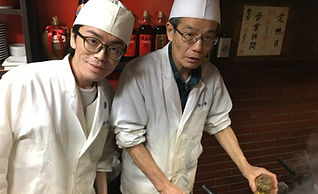Chinmitei: a Third Generation Taiwanese Restaurant
Walking down the lively drinking street on the southside of Nishiogi Station, it would be easy to miss the humble Taiwanese restaurant now surrounded by the smoking grills of the growing Ebisu yakitori empire. But it has a 53-year history in the area. With a ten person seating capacity in a narrow space, Chinmitei is a Taiwanese-Japanese family run restaurant. It is only open at night when the mostly male regulars file in for a taste of the specialties on the time-tested menu, and often a glass of Shaoxing rice wine from China.
Chinmitei is a third generation immigrant business. It is now run by Hayashi Nobusuke, and his son Hayashi Kenji. It was opened by Kenji-san’s grandfather, who came to Japan from Taiwan before World War II. The grandfather worked in a Chinese restaurant after coming to Japan, learned to cook from another Taiwanese friend, and finally started his own restaurant in 1955 in the famous “Memory Lane” drinking alley (Omoide Yokocho) in Shinjuku. He then moved to Nishiogi in 1963, chose a drinking street with a similar atmosphere for his restaurant. Indeed, like Shinjuku's Memory Lane, the South Market in Nishiogi similarly developed out of a post-war black market.
Nobusuke-san explained the evolution of the business: “My father failed completely with his restaurant in Shinjuku. He hired about ten people to help. He was cheated, and had all kinds of trouble. So when he started this shop, he decided to keep it in the family. Well, it is a small shop so two people would be enough to run it. Well, my father can make all kinds of dishes, but he decided to specialize in what we do. Because we make everything on our own, I think we also improved our efficiency.” Chinmitei is famous for its glass noodles (bifun/mifen) and pig's feet (tonsoku/zhujiao).
Nobusuke-san also told us how the drinking culture has been preserved in the neighborhood: “The drinking culture in Nishiogi is just like how it was back then. We chat with customers, exactly like Showa-era,” said Nobusuke-san. “It is called “ladder drinking” (hashigo = bar-hopping). People go drinking in more than three shops in a day. That is what people used to do in the old days too.”
He also described some changes in the drinking culture: “Well, it used to be common for managers take subordinates out drinking, and pay with company money because it was included in the expense accounts. Now, they have to pay with their own money.”
Like many long-term residents, however, Nobusuke-san emphasized the continuities in the neighborhood geography. “Nishiogi really did not change much. No major development happened in the area, so it looks pretty much the same. Just the shops and restaurants are slightly different now. The drinking culture in Nishiogi is quite unique, and it is very well preserved.”
The younger Kenji-san, who speaks good English after a year in Canada, expressed his hope that the drinking culture could develop beyond this male-dominated scene. “Too often we see male costumers eating and drinking alone,” he said. “I wish they could take their girlfriends or wives. I believe there is a special happiness that come from dining together with other people.”
Much like Manfuku Hanten which we wrote about earlier, Chinmitei is another example of the traditional “neighborhood Chinese” restaurants in Nishiogi. It also retains its own family traditions for over half a century. Both Nobusuke-san and Kenji-san stated that they hope this restaurant can continue for as long as possible, and that they will try to make that happen (James Farrer, Tong Liu, Nov. 3, 2016).







